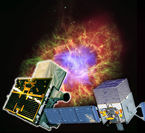Find out the latest thinking about our universe.
-
bystander
- Apathetic Retiree
- Posts: 21577
- Joined: Mon Aug 28, 2006 2:06 pm
- Location: Oklahoma
Post
by bystander » Mon Mar 07, 2011 3:08 am
 HEAPOW: What's Eating the Crab? (2011 Feb 28)
HEAPOW: What's Eating the Crab? (2011 Feb 28)
The
Crab Nebula, the remains of a star which exploded in A. D. 1054, is regarded by astronomers as one of the steadiest sources in the sky. So steady, in fact, that it's used as a standard source against which nearly all high energy satellite observatories are
measured and calibrated. But recently something seems to be bothering the Crab. A surprising measurement of the Crab by the
Agenzia Spaziale Italiana's
AGILE Gamma-ray observatory (shown on the lower left in the above image of the Crab Nebula) found that the Crab varied in its gamma-ray output by a factor of 3 in September 2010. This change was also confirmed by NASA's
Fermi Gamma-ray Space Telescope (superimposed above, lower right) as well. Astronomers suspected something strange going on with the
central pulsar (a rapidly spinning neutron star) that powers the emission from the nebula, but followup observations using the
Hubble Space Telescope and the
Chandra X-ray observatory showed no real change in the pulsar in optical or X-ray wavelengths, and gamma-ray emissions showed it
pulsing regularly at about 30 times per second as it nearly always does. So why is the Crab so crabby? Astronomers think the gamma-ray flare might have been produced by a strong shock wave moving through the nebula at near the speed of light.
AGILE Discovers Crab Nebula Flares
http://asterisk.apod.com/viewtopic.php?f=31&t=21399
Know the quiet place within your heart and touch the rainbow of possibility; be
alive to the gentle breeze of communication, and please stop being such a jerk. — Garrison Keillor
-
neufer
- Vacationer at Tralfamadore
- Posts: 18805
- Joined: Mon Jan 21, 2008 1:57 pm
- Location: Alexandria, Virginia
Post
by neufer » Mon Mar 07, 2011 9:58 pm
bystander wrote: HEAPOW: What's Eating the Crab? (2011 Feb 28)
So why is the Crab so crabby? Astronomers think the gamma-ray flare might have been produced by a strong shock wave moving through the nebula at near the speed of light.
I'd never heard of a shock wave that could travel at near the speed of light

http://en.wikipedia.org/wiki/Shock_waves_in_astrophysics wrote:
<<Shock waves are common in astrophysical environments. Several examples of astrophysical shock waves are:
* Supernova remnants driving a shock through the interstellar medium (ISM).
* The Earth's bow shock.
* Shocks traveling through a massive star as it explodes in a core collapse supernova.
* Shocks in interstellar gas, cased by a collision between molecular clouds or by a gravitational collapse of a cloud.
* Accretion shocks at the edge of galaxy clusters.
Because of its low density, most shocks in the interstellar medium are collisionless. This means that the shocks are not formed by two body Coulomb collisions, since the mean free path for these collisions is too large. It is widely accepted that the mechanism driving these shocks consists of plasma instabilities, that operate on the scale of plasma skin depth, which is typically much shorter than the mean free path. It is known that shocks in astrophysical systems have extremely high energy particles in them, though the evidence has not yet well established a definite answer about whether the particles emitting high energy photons are protons, electrons or both. The common picture of how these particles accelerate is called Fermi acceleration. It is usually agreed that shocks caused by supernova remnants expanding in the interstellar medium accelerate the cosmic rays measured above the Earth's atmosphere.
Shock waves in stellar environments, such as shocks inside a core collapse supernova explosion often become radiation mediated shocks. Such shocks are formed by photons colliding with the electrons of the matter, and the downstream of these shocks is dominated by radiation energy density rather than thermal energy of matter.
An important type of astrophysical shock is the relativistic shock. These shocks are unique to astrophysical environments, and can be either collisionless or radiation mediated. Relativistic shocks are theoretically expected in gamma ray bursts, active galactic nucleus jets and in some types of supernova explosions.>>
Art Neuendorffer
 HEAPOW: What's Eating the Crab? (2011 Feb 28)
HEAPOW: What's Eating the Crab? (2011 Feb 28)
